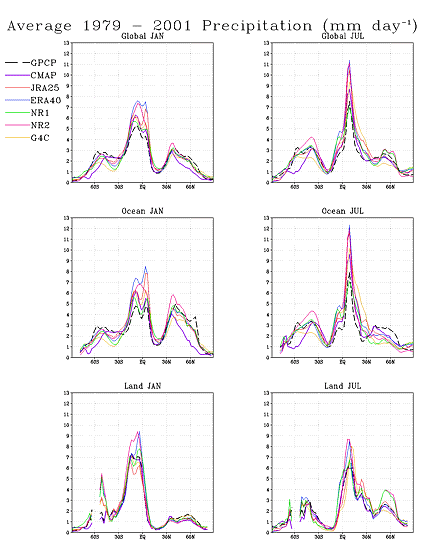MERRA: MODERN ERA-RETROSPECTIVE ANALYSIS FOR RESEARCH AND APPLICATIONS
Reanalysis Precipitation Climatology
This page supplements the article in the Journal of Applied Meteorology and Climatology, Evaluation of Precipitation in Reanalyses by M. Bosilovich, J. Chen, F. R. Robertson and R. F. Adler.
Reanalysis precipitation is generally considered to have significant uncertainty on all time and space scales. Here we have posted some comparisons of 5 long global reanalyses with the GPCP and CMAP merged satellite/gauge data products. The table below provides climate mean maps of each month's precipitation and the differences from GPCP. Each data set has been regridded to fit GPCP's grid (288x144 points). Additionally, Zonal averages for January and July's global, ocean and land precipitation are presented, along with a table comparing the different reanalyses bias in many regions and latitude bands.
The reanalyses are: The Japanese 25 year Reanalysis (JRA-25) is the most recent, released for use in March 2006 (Onogi et al., 2007). The 45 year ECMWF reanalysis (ERA40, Uppala et al. 2005), which stops in August 2002. The National Centers for Environmental Prediction (NCEP) has released two reanalyses labeled here as NR1 (NCEP-NCAR, Kalnay et al 1996) and NR2 (NCEP-DOE, Kanamitsu et al. 2002). We also include a reprocessing of this period using the NASA GEOS4 (Global Earth Observing System version 4) data assimilation system (Bloom et al. 2005). GEOS4 was the operational analysis for NASA from 2003 through 2006. Because GPCP (Adler et al. 2003) is comprised of observations with global coverage, it will be used as the reference data set. However, GPCP precipitation does have uncertainty. The CMAP precipitation (Xie and Arkin, 1996) will be compared to GPCP in an effort to represent uncertainty. There have been several key studies comparing GPCP and CMAP which provide more information on their differences in formulation and results (Gruber et al. 2000 and Yin et al. 2004).
The figures and data on this page are not intended to cover every possible comparison between the observations and reanalyses, but rather a brief overview of the climate scale bias. For example, all the reanalyses exhibit some high bias over the western Tropical Pacific ocean (and more generally all the tropics (15S-15N). Interestingly, all the reanalyses and CMAP underestimate the precipitation over the well-gauged European continental region in January.
Further discussion on this page, and questions and comments can be posted on the MERRA Blog

Table Caption: Area average GPCP precipitation and differences of the Reanalyses and CMAP from GPCP (mm day-1) for the globe, several latitude bands and several large scale regions. The data are time averaged from 1979 to 2005 (when data are present) for (a) January and (b) July.(Click on figure for larger version.)

Fig. Caption: January and July zonal averages for 5 reanalyses, CMAP and GPCP, averaged for the Globe, Ocean and Land areas. (Click on figure for larger version.)
| Time Frame | Plotted Values | |
|---|---|---|
| Annual | Mean | Diff |
| January | Mean | Diff |
| February | Mean | Diff |
| March | Mean | Diff |
| April | Mean | Diff |
| May | Mean | Diff |
| June | Mean | Diff |
| July | Mean | Diff |
| August | Mean | Diff |
| September | Mean | Diff |
| October | Mean | Diff |
| November | Mean | Diff |
| December | Mean | Diff |
Table Caption: Climate averaged annual and monthly mean precipitation and differences from GPCP for each of the reanalyses and CMAP. In these, the averaging period is 1979-2001, when satellite data are available and all reanalyses have data avalable (ERA40 stops in Aug 2002).
References
Adler, R. F., G. J. Huffman, GJ; A. Chang, and co-authors., 2003: The version-2 global precipitation climatology project (GPCP) monthly precipitation analysis (1979-present). J. Hydromet., 4, 1147-1167.
Bloom, S. C., A. da Silva and D. Dee, 2005: Documentation and Validation of the Goddard Earth Observing System (GEOS) Data Assimilation System Version 4. Vol. 26, NASA Technical Memorandum 104606, NASA Goddard Space Flight Center, 165 pp.
Gruber, A., X. Su, M. Kanamitsu and J. Schemm, 2000: The comparison of two merged rain gauge satellite precipitation datasets. Bull. Amer. Met. Soc., 81, 2631-2644.
Gu, G., R.F. Adler, G.J. Huffman, and S. Curtis, 2007: Tropical Rainfall Variability on Interannual-to-Interdecadal and Longer Time Scales Derived from the GPCP Monthly Product. J. Climate, 20, 4033.4046.
Kalnay, E. and co-authors, 1996: The NCEP/NCAR 40-Year Reanalysis Project. Bull. Amer. Meteor. Soc., 77, 437-431.
Kanamitsu, M., W. Ebisuzaki, J. Woollen, S-K Yang, J.J. Hnilo, M. Fiorino, and G. L. Potter, 2002: NCEP-DOE AMIP-II Reanalysis (R-2). Bull. Amer. Met. Soc., 83, 1631-1643.
Onogi, K. and co-authors, 2007: The JRA-25 Reanalysis. J. Met. Soc. Japan, 85, 369-432.
Uppala, S. M., and co-authors, 2005: The ERA-40 re-analysis, QJRMS, 131 Part B, 2961-3012.
Xie P., and P. A. Arkin, 1996: Global precipitation: a 17-year monthly analysis based on gauge observations, satellite estimates, and numerical model outputs. Bull. Amer. Meteor. Soc., 78, 2539-2558.
Yin, XG; Gruber, A; Arkin, P, 2004: Comparison of the GPCP and CMAP merged gauge-satellite monthly precipitation products for the period 1979-2001. 5 (6): 1207-1222.


